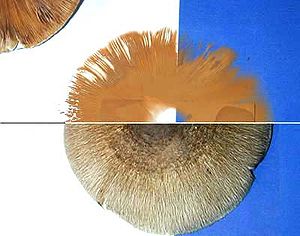
Spore print
Encyclopedia

Mushroom
A mushroom is the fleshy, spore-bearing fruiting body of a fungus, typically produced above ground on soil or on its food source. The standard for the name "mushroom" is the cultivated white button mushroom, Agaricus bisporus; hence the word "mushroom" is most often applied to those fungi that...
is an important diagnostic character in most handbooks for identifying mushrooms. It shows the color of the mushroom spore
Spore
In biology, a spore is a reproductive structure that is adapted for dispersal and surviving for extended periods of time in unfavorable conditions. Spores form part of the life cycles of many bacteria, plants, algae, fungi and some protozoa. According to scientist Dr...
s if viewed en masse. A spore print is made by placing the spore producing surface flat on a sheet of dark and white (or just white) paper
Paper
Paper is a thin material mainly used for writing upon, printing upon, drawing or for packaging. It is produced by pressing together moist fibers, typically cellulose pulp derived from wood, rags or grasses, and drying them into flexible sheets....
or on a sheet of clear, stiff plastic, which facilitates moving the spore print to a darker or lighter surface for improved contrast; for example, it is easier to determine whether the spore print is pure white or, rather, very slightly pigmented. The mushroom is left for several hours, often overnight, in this manner. When the mushroom is removed, the color of the spore
Spore
In biology, a spore is a reproductive structure that is adapted for dispersal and surviving for extended periods of time in unfavorable conditions. Spores form part of the life cycles of many bacteria, plants, algae, fungi and some protozoa. According to scientist Dr...
s should be visible. Mycologists
Mycology
Mycology is the branch of biology concerned with the study of fungi, including their genetic and biochemical properties, their taxonomy and their use to humans as a source for tinder, medicinals , food and entheogens, as well as their dangers, such as poisoning or...
often use glass slides, which allow for quick examination of spores under a microscope. A mushroom cannot be identified from its spore print alone; the spore print is only one characteristic used in making a taxonomic determination.
Historically the classification of many families of fungi were based on spore colour, an example being Tricholomataceae
Tricholomataceae
The Tricholomataceae are a large family of mushrooms within the Agaricales. A classic "wastebasket taxon", the Tricholomataceae is inclusive of any white-, yellow-, or pink-spored genera in the Agaricales not already classified as belonging to the Amanitaceae, Lepiotaceae, Hygrophoraceae,...
being a large family containing many fungi whose common factor was having white spores. However recent molecular research has shown some interesting relationships, with some fungi of disparate spore colours showing close relations.

